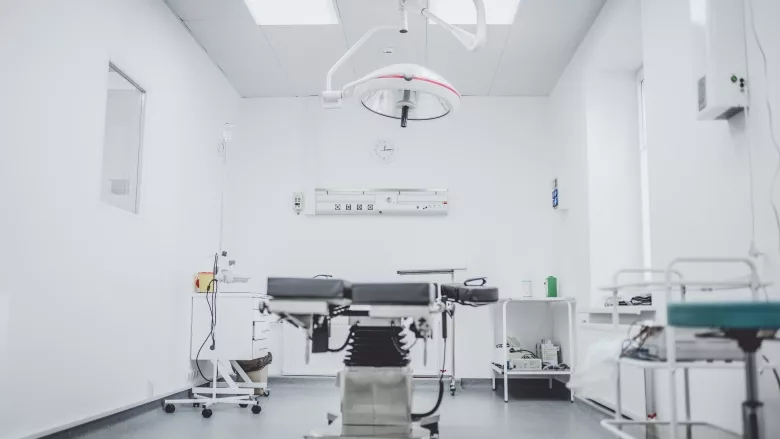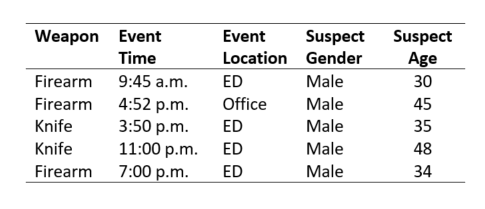June 2022 saw 5 violent attacks in US hospitals

Image from Unsplash
Five violent incidents occurred in U.S. hospitals throughout the month of June 2022. According to the Federal Bureau of Investigation (FBI)’s active shooter statistics, June typically trends higher than the other months with activity year-over-year.
Five healthcare facility (HCF) shootings and stabbings resulted in death or significant injury throughout the summer, with incidents taking place across the United States.
June 2022 hospital violence summary
 Image courtesy of Kemper
Image courtesy of Kemper
Miami Valley Hospital in Dayton, Ohio. On June 1 at 9:45 a.m. a forensic patient in the emergency department was seeking medical treatment. The 35-year-old male suspect removed the firearm from a security guard, fatally shooting the guard and himself.
St. Francis Hospital and Medical Center in Tulsa, Oklahoma. On June 1 at 4:52 p.m., a 45-year-old male opened fire in a physician's office practice, killing two doctors, one nurse and one visitor.
Encino Medical Center in Encino, California. On June 3 at 3:50 p.m. a 35-year-old male stabbed two nurses and a physician in the emergency department. The suspect was arrested after staff barricaded him in a closet.
UMC Hospital in Las Vegas, Nevada. On June 23 at 11:00 p.m., a 48-year-old male patient in the emergency department’s Behavioral Health unit stabbed two patients, killing one. The patient was arrested by law enforcement with the help of facility security.
Baylor Scott and White Medical Center in Irving, Texas. On June 29 at 7:00 p.m., a 34-year-old male patient asked emergency department staff what to do with his firearm and was acting suspiciously. Upon arrival, the patient shot at law enforcement who returned fire and killed the suspect.
Violence prevention best practices identified
In most of the above events, staff quickly identified escalating or unsafe conditions and responded quickly by removing themselves and others away from harm, resulting in numerous saved lives.
- Identify escalating/unsafe conditions: Healthcare workplace violence occurs at an extremely high rate within emergency departments. Patients are typically scared and in pain, and emotions tend to peak quickly with little or no sign. At the Baylor Scott and White event, nurses appeared to have noticed the patient acting suspiciously and quickly exited the room and called security and law enforcement.
- Quick response: In most of the above events, staff quickly responded to the situation and called for security/law enforcement assistance. At the St. Francis event, staff and visitors helped each other evacuate and secured the individual on the floor. At the Encino event, clinical staff barricaded the individual in the room until law enforcement arrived. While at the Baylor Scott and White event, law enforcement quickly arrived and approached the individual while he was still in the patient room.
There were several trends amongst these events. All suspects were male between the ages of 30-50 years old. Eighty percent of the events occurred just after the individual showed signs of agitation or voiced complaints/concerns from minutes to days leading up to the event.
Risk mitigation strategies
There are several administrative, behavioral and physical controls that healthcare facilities can implement to dramatically reduce risk. Healthcare security leaders should understand the risks of workplace violence and implement controls to mitigate those risks. Simply adding more security personnel may not mitigate the specific risks. Below are several security recommendations, listed by priority, that healthcare leaders should consider implementing to prevent active shooter or mass casualty events from occurring within the facility.
- Limit entryways with access control: During COVID-19, HCFs activated limited access into the facility to a handful of entry points and implemented screening of every individual entering the facility. Healthcare facilities should consider maintaining a similar access level into their facility moving forward to manage and maintain safety and security as the new normal.
- Implement metal detectors at all points of entry: Metal detectors screening individuals and their belongings at entry points can help eliminate knives and firearms from entering the facility. Employees, visitors, patients and contractors should all be included in the screening. HCFs should also become familiar with the state Guns at Work laws to minimize or limit liability exposure.
- Maintain a safe work environment: From maintaining a clean environment to conducting environmental or individual searches, best practices include assessing agitated individuals (BROSET Assessment) upon triage and obtaining a history and safety assessment if the individual is known to be violent. Conducting frequent environmental and individual searches once a shift or upon shift change can help reduce violence. A search of an individual should include their belongings and their person.
- Tasers, not firearms: Ninety percent of healthcare violence is between patients and healthcare providers or coworkers. Healthcare security leaders should consider swapping out security firearms with tasers to reduce the risk of death and casualty count. There are numerous reports where firearms held by security or law enforcement officials have been taken away by a suspect. An HCF may consider having firearms available only in situations where there is an active shooter threat.
- Weapons signage & policy: Each state has its own weapons laws regarding public and private businesses. For the above sites, each site had a weapons policy and had signage posted at public entrances. Signage and policies have an important role in alerting individuals of weapons policies, but they may carry little weight in preventing weapons from entering the facility. If HCFs allow security to carry firearms, they should review the weapons policy or use of force policy to determine if there is clear use of force criteria.
Looking for a reprint of this article?
From high-res PDFs to custom plaques, order your copy today!








